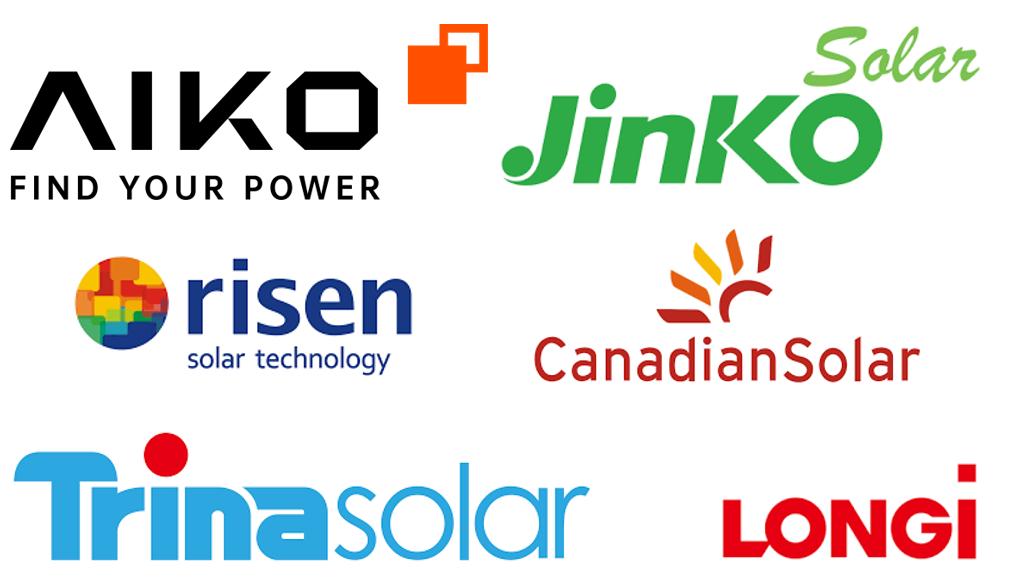Solar panel prices - Updated July 2025

Top 5 most popular panels:-
(1) Aiko Neostar 2P 475W
Highest efficiency of any panel available at 23.8%
Black frame.
All back contact design for improved performance in partial shade.
'N' type cells with 30 year performance warranty, 25 year panel defect warranty.
Can have up to...
22 x 475W (10.45kW) on a three phase 1000V inverter string.
13 x 475W (6.175kW) on a single phase 600V inverter string.
475W panel price $195 inc GST
Less current subsidy (STCs) $150
End user pays $45 per panel + labour and roof fixings.
(2) JinKo Neo 440W All Black
Efficiency 22%
All black makes this more aesthetically pleasing on a white or black roof, not so much on terracotta.
'N' type cells with 30 year performance warranty, 25 year panel defect warranty.
Can have up to...
23 x 440W (10.12kW) on a three phase 1000V inverter string.
13 x 440W (5.72kW) on a single phase 600V inverter string.
440W panel price $154 inc GST
Less current subsidy (STCs) $137
End user pays $17 per panel + labour and roof fixings.
(3) Risen RSM108-9 - 440W
Efficiency 22.5%
Black frame.
'N' type cells with 30 year performance warranty, 25 year panel defect warranty.
Can have up to...
23 x 440W (10.12kW) on a three phase 1000V inverter string.
13 x 440W (5.72kW) on a single phase 600V inverter string.
440W panel price $138 inc GST
Less current subsidy (STCs) $137
End user pays $1 per panel + labour and roof fixings.
(4) Canadian Solar C66R - 440W
Efficiency 22.5%
Black frame.
'N' type cells with 30 year performance warranty, 25 year panel defect warranty.
Can have up to...
23 x 440W (10.12kW) on a three phase 1000V inverter string.
14 x 440W (5.72kW) on a single phase 600V inverter string.
440W panel price $152 inc GST
Less current subsidy (STCs) $137
End user pays $15 per panel + labour and roof fixings.
(5) Trina Vertex TSM-500NEG18R.28/.20 - 500W
Efficiency 22.5% (1961 x 1134mm).
Black frame, dual glass, but power production from front only.
'N' type cells with 30 year performance warranty, 25 year panel defect warranty.
Can have up to...
23 x 440W (11.5kW) on a three phase 1000V inverter string.
14 x 440W (6.5kW) on a single phase 600V inverter string.
500W panel price $195 inc GST
Less current subsidy (STCs) $155
End user pays $40 per panel + labour and roof fixings.
Other panels
Seraphim, LonGi, Eging 440W panels are almost identically priced to (3) Risen above.
There are in fact over 8,000 panels approved by the Clean Energy Council for install in Australia.
We only see a fraction of them over here in WA and I suspect most of them aren't available over East either.
Premium panels
There used to be 4x premium panel brands.
Q.Cells, LG, Sunpower and REC.
The first two have quit Australia saying it's too small a market and too competitive.
How long the other two stick around is anyone's guess.
We won't sell them because they are electrically too unique.
If one were to fail, and the manufacturer has folded, there's nothing to replace the faulty panel with.
As we won't sell them, I won't list the prices for REC Alpha & Sunpower Maxeon, but it's very high, relative to the above.
Used panels
We do a great many replacement systems.
We have a guy who scoops up the old panels, inverters and rail and sends it all to Africa for a second life.
It's great to think of a small village somewhere in Africa being powered by perfectly good old panels.
People often call us asking if we have any old panels for their farm or hobby project.
Yes, but...
If you are prepared to take everything, all the panels, inverter, rails then Africa can have a little less.
We'll tell you the address and day you need to go get it. There's usually no cost unless the client insists on getting something.
However, you have to take everything and you have to pick it ALL up on the same day we are installing the new system.
Our clients won't accept it sitting on their driveway or killing their front lawn for days while you find some time.
The Government STC Subsidy
The above 'end user pays' prices are all based on a fully complaint complete NEW system.
New inverter, new panels, new wiring, new roof fixings, all installed by suitably SAA accredited solar electricians.
We rarely add panels to existing systems unless the new panels are a very close electrical match to the old.
If you would like a solar quotation, in Perth, then call us on...
(08) 9467 9655
or email
This review was written by Andrew MacKeith, Solar4Ever service manager since 2011.
Solar4Ever is located in Morley (Perth), WA 6062
